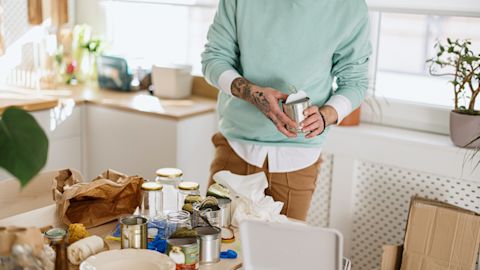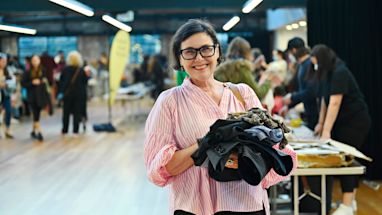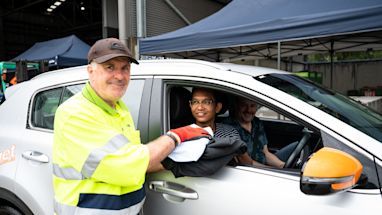You’re not alone if you’ve ever questioned what happens to your recycling.
If you’ve taken the time to sort your cardboard, bottles, jars, cans and containers from your rubbish, you can rest assured your recycling efforts aren’t going to waste.
From roads to packaging, every item can have a second life.
Collection
Once our trucks pick up the recycling from your home, it’s taken to a transfer station in Alexandria.
There, it’s mixed with recycling from nearby council areas and transported to a recycling plant in Smithfield, western Sydney.
On average 84% to 96% of items put in the yellow lid bin are recycled. The rest goes to landfill. This is usually because of incorrect items, like soft plastics, being put into recycling bins.

Processing
Once the truck is unloaded, the recycling is put onto conveyor belts and employees manually remove large items that could damage the machinery including bagged recycling.
Machines sort the rest. Using magnets, star screens, trommels, infrared lights and air, the items are divided into paper, cardboard, plastic, glass, steel and aluminium.

Paper and cardboard
Transferred by conveyer belt to the onsite paper mill, paper and cardboard are cleaned, pulped and remanufactured. They become products like kraft paper and corrugated carboard boxes used by the packaging and food industries.
Pro recycling tip: it doesn’t matter how oily or greasy your cardboard pizza box is. If it’s empty, it can be recycled in your yellow lid bin. So, make sure you eat every last slice.
Glass bottles and jars
Glass is taken to a glass recycling plant in Penrith, where it’s separated into colours and heated in a furnace to create molten glass.
After it’s cooled, shears cut the molten glass into gobs, which are dropped into moulds. Compressed air is used to shape the gob into a glass container. These new bottles and jars are inspected for strength and quality before being sold to food and beverage manufacturers. They end up right back on the supermarket shelves with brands like Vegemite, Dolmio and Masterfoods using recycled jars as their packaging. Once empty, these can be recycled again.

Glass that doesn’t make the cut to be recycled into bottles and jars can be used to pave roads. About 135,000 recycled glass bottles have been turned into sand to resurface these local streets:
- Bent Street, Sydney
- Doody Street, Alexandria
- Gordon Street, Paddington
- Lang Road, Moore Park
- Malcolm Street, Erskineville.
Using recycled crushed glass sand in road construction replaces the need to use natural sand.
Pro recycling tip: If your glass bottle has a metal top that can’t reattach, like a beer bottle, put a few inside a tin can and squeeze the lid shut for easy recycling. They’re too small to be recycled by themselves.
Plastic bottles, trays and containers
Plastics are sorted into types with optical sorting machines. Bottles made from PET and HDPE plastic, like water and milk bottles, are processed onsite at Smithfield. These plastics are shredded, washed, sterilised and turned into plastic pellets. These pellets are sent to Albury, where they are injected into moulds and compressed air shapes them into new bottles.
Other coloured plastics, such as those from plastic containers and meat trays, join the mixed plastics stream. They’re separated into colours and sold to processing partners. They can be made into a variety of materials including road base and weed mats.
Pro recycling tip: Leave lids and labels on your plastic bottles. That way they won’t get lost or jam the recycling machinery.
Aluminium foil, trays and beverage cans
Aluminium is crushed, baled and sent to an aluminium smelter overseas. There it’s shredded, melted and turned into aluminium coils. These are imported back into Australia, where they’re remanufactured into aluminium beverage cans.
Pro recycling tip: aluminium foil can be recycled. Just scrunch it into a big ball, about the size of a tennis ball, so it’s heavy enough for the recycling machinery to sort it. You can combine small bits of foil until you have enough to put in the yellow lid bin.
Steel food cans
Steel is crushed, baled and sent to a local processor, where it is shredded, melted and turned into steel rolls. These rolls are welded, formed into cylinders and lids are attached. The new can is sold to food companies.
Pro recycling tip: remove all food and liquid from cans before recycling, otherwise they’ll end up in landfill.

Check before you buy
Next time you put an item in your yellow lid bin, or down the recycling chute, you can trust it will be treated as a valuable resource and used to remanufacture new products.
So, when you’re browsing the shopping aisles, check to see if the item can be recycled before you buy it. Look out for the Australasian Recycling Label – a classification system for packaging that makes recycling easier. This label tells you which part of the package belongs in the recycling bin, the rubbish bin, or if you need to do something else with it.
Better yet, choose products made from recycled materials. This is a big step in creating a circular economy and preserving our environment.
Published 22 October 2021, updated 11 March 2024



